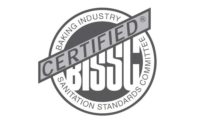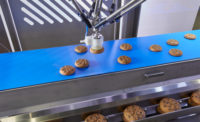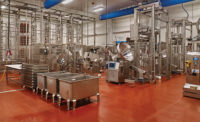Sanitary equipment design is essential to ensuring food safety in the snack and bakery industry. To that end, the Baking Industry Sanitation Standards Committee (BISSC) has established standards and guidelines for the design and operation of equipment. By applying accepted BISSC standards, engineers can design and build equipment that minimizes the chance of food contamination.
The existence of these guidelines, along with an organization that promotes them, prompts manufacturers to ensure that consumers are eating baked snacks and a wide range of baked goods manufactured with equipment that is held to a high level of sanitation standards. Use of proper machine coatings and elimination of accumulation pockets are two important areas covered by the guidelines.
Evolution of the standards
The American National Standards Institute (ANSI) guidelines for baking equipment comprise two standards, the ANSI Z50.1 standard for equipment safety and ANSI Z50.2 standard for baking sanitation. Approval of a standard requires verification by ANSI.
The Baking Industry Sanitation Standards Committee (BISSC) was established in 1949 to develop and publish voluntary standards for the design and construction of bakery equipment. Today, those standards—which have seen regular updates—are recognized as the definitive sanitation guidelines for equipment used in the bakery industry.
The BISSC Office of Certification was established in 1966 to promote greater recognition and use of equipment conforming to the criteria of BISSC standards. It offers two equipment certification programs to manufacturers with equipment built to ANSI/ASB/Z50.2-2013 Sanitation Standard for the Design of Bakery Equipment criteria:
Certification. Manufacturers who can warrant that equipment conforms to the criteria of the ANSI/ASB/Z50.2-2013 Sanitation Standard for the Design of Bakery Equipment can display the BISSC Certified symbol on the equipment.
Third-party verification. Manufacturers already registered and certified with BISSC who successfully pass a third-party inspection by a BISSC-appointed, independent testing agency can display the BISSC Verified symbol.
BISSC is a not-for-profit corporation that, working with the American Society of Baking (ASB) Z50 Committee, developed an ANSI standard for the design of bakery equipment. That standard provides guidance for a variety of manufacturing equipment regarding proper design for sanitation and food safety. BISSC became a subsidiary of AIB International in 2007.
Jesse Leal, inspector, AIB International, Manhattan, KS, teaches the BISSC certification course and says that BISSC initiated the third-party verification program in 1998 to enhance the value of the BISSC symbol.
“AIB assisted BISSC in the design and implementation of this program. Manufacturers of baking equipment must be registered and certified with the BISSC office in order to participate. Some state agencies now accept the BISSC certification for new equipment design before permits and licenses can be issued for operation,” Leal says.
“Making sure that our machines have a BISSC certification is important to us and our customers. We invest in our engineering team year after year to make sure they are up to date with the new standards,” says Sergio Caballero, regional sales manager, FoodTools, Santa Barbara, CA.
The last update to the BISSC Z-50 standards occurred in 2015 to include information on coatings, elimination of accumulation pockets and specific requirements on parts with magnetic properties, according to Leal. “The elimination of pockets or crevices to eliminate the potential of microbial and pest harborages is one of the most recent changes, including bolts with crevices where food accumulation can occur. Pieces or small removable parts, like nuts and bolts, should have magnetic properties in case they become loose. This way they can be detected by metal detection devices before resulting in contamination.”
“As with any standards, they create a baseline that multiple companies can work with and work from. Pertaining to BISSC, the organization has done the research to find out what works best for everyone involved,” says Ed Urevich, engineering manager, Charles Ross & Son Co., Hauppauge, NY.
Key features
The BISSC standard has helped manufacturers upgrade their snack and bakery equipment to reflect the most-important aspects of sanitary design.
“The BISSC standard is important because it was developed in a reasonable way over a number of years and applies specifically to the needs of the bakery industry. It provides detailed instructions on how to make equipment that can be cleaned and will not negatively affect the product being produced,” says Bill Sutton, business development manager, Kollmorgen Corp., Radford, VA.
Kollmorgen has designed a servo motor that can withstand daily washdown. It is constructed of 316L stainless steel, and the cable is designed to withstand washdown. The motor is vented so that no vacuum is created inside during the heating and cooling cycles inherent in production and cleaning.
“Also, the motor has a smooth surface finish. There are no metal-to-metal seams, no external hardware and no nooks or crannies to harbor product or pathogens. These features make the motor easy to clean, reducing food safety risk,” Sutton says.
In addition to the food safety factors inherent in this process, peak sanitary design can also help reduce downtime. “The one aspect that stands out is the ease of cleaning our machines and the changeover from product to product. Downtime costs money, so the faster they can change over the better,” Caballero says.
“Equipment that is easy and quick to disassemble, clean and reassemble without cross-contamination from one product to the next is one of the most-important factors in designing equipment for the bakery industry. Also, machines that can be disassembled and reassembled without the need for tools is of high importance,” says Lance Aasness, executive vice president, Hinds-Bock, Bothell, WA.
Most Hinds-Bock equipment can be fully washed down and sanitized within minutes. One of the newest designs is the clean-in-place (CIP) sanitary pumps. “Not only do they sanitize themselves and have fewer parts to clean, they also help prevent waste by moving any leftover product from within the walls of the cylinder, nozzles and hoses. In addition, Hinds-Bock servo pump fillers feature CIP with hinged front cover plates, which allows for rapid swab testing,” Aasness says.
Stewart Macpherson, vice president, sales and marketing, Unifiller Systems Inc., Delta, British Columbia, adds two key aspects to the successful design of sanitary equipment:
- The equipment must be easy to disassemble, clean and sanitize by an inexperienced operator, without tools or instructions
- The equipment must be designed with food-grade materials and with the fewest number of contact parts possible
The RP depositor from Unifiller encompasses the company’s simplicity-of-design principle. The machine uses an internal rotary piston design, and is held together with two stainless steel shafts. “Only two knobs need to be removed to disassemble the machine in less than 20 seconds. About 80 percent of Unifiller’s machines are air-operated and can be washed down with a powered water hose,” Macpherson says.
Moline Machinery, Duluth, MN, designs its sheeting systems for full washdown construction. “In a USDA environment, a full washdown occurs daily. This means that sheeting systems require convenience features such as quick-release belting and CIP units,” says David Moline, P.E., vice president, sales and marketing.
“Moline doughnut proofers can be equipped with CIP tray-washing systems that save hours of labor per cleaning and carry a quick return on investment. Moline doughnut fryers, while intended for 24/7 operation, are designed to withstand caustic chemical solutions and regular, rigorous cleanings,” Moline adds.
Ashworth Bros. Inc., Winchester, VA, has introduced Omni-Grid 360 weld belts. In accordance with BISSC guidelines, they have a smooth 360 degree weld on the outside belt edge, which provides an easy-to-clean surface. “Previous grid-style belts, in similar applications, utilized bridged welds that can leave hidden entrapment areas between the weld and the drive link, making them more challenging to clean,” says Jonathan Lasecki, chief engineer.
The BISSC standards will continue to evolve in the near future. “As food safety regulations and requirements change,” says Leal, “BISSC will look to modify or change its design requirements to ensure that baking equipment design remains current with industry and regulatory requirements.”












